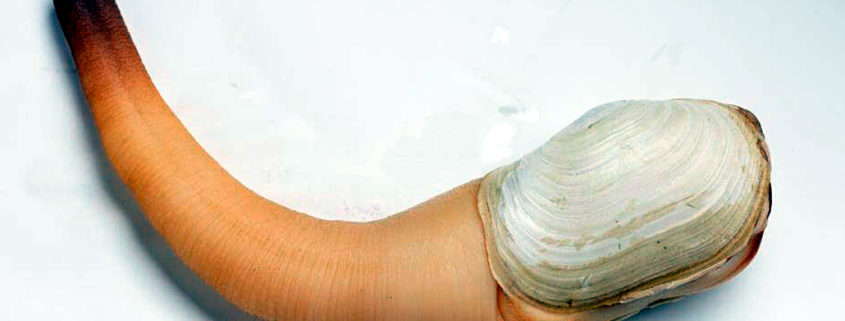Pacific Geoduck Author: Zoe Schmit Common Name: Geoduck Scientific Name: Panopea genersoa Photo courtesy of Grant Dovey of the Underwater Harvesters Association and the West Coast Geoduck Research Corporation. Identifying Features: My friend said it looks like a foot made of cream cheese while others say a skinned yam and then there are those that eat it as a tasty meal. Behold! The most phallic looking bivalve: the Geoduck (Panopea genersoa)! The Geoduck (Panopea genersoa) is the largest bivalve in the Northern Pacific and Salish Sea areas, and the largest burrowing bivalve in the world. It has a thin shell that can reach up to 8 inches long, which always remains open, due to how large the clam is. The neck or siphons of the the clam can reach up to 1 metre in length. Its weight can also reach up 1.5 kilograms. Habitat: P. genersoa is found in the intertidal zone of sandy beaches. The intertidal zone is where the ocean meets the land and is covered by water during high tide and is exposed land during low tide. P. genersoa burrows itself under the sand, sometimes up to 110 metres down. The geoduck is found in Puget Sound, Washington, along the coast of British Columbia and Japan. Food (prey): Geoducks are filter feeders. They eat mainly plankton. They siphon it in, eat it, and then eject the waste. Predators: P. genersoa doesn’t have too many predators; the Sea Otter (Enhydra lutris), Spiny dogfish (Squalus acanthias) and people (Homo sapiens). To avoid these predators the Geoduck simply buries itself deeper in the sand. Humans harvest the Geoduck and serve them as a delicacy. Life Cycle: P. genersoa can live to be 168 years old. To reproduce, the males spawn and the females produce 7-10 million eggs which are fertilized externally. 48 hours after being born, the shelled larvae begin swimming and eventually settle on the sandy bottom. Recipe for Geoduck Fritters: Ingredients * 1 cup flour References: Andy, L. and Bernard, H. (2005) Marine life of the pacific northwest: A photographic encyclopedia of invertebrates, seaweeds and selected fishes. Madeira Park, BC: Harbour Publishing Geoduck Recipes Geoduck Recipes. Retrieved January 2, 2017 from http://www.geoduckrecipes.com/ Goodwin, C.L. ; Pease, Bruce (Dec, 1989) Species Profiles, Life Histories and Environmental REquiremetns of Costal Fishes and Invertebreates (Pacific Northwest). Pacific Geoduck Clam Retrieved November 9, 2016 from http://oai.dtic.mil/oai/oai?verb=getRecord&metadataPrefix=html&identifier=ADA225230 Jerry Cahill. Geoduck “Gooey Duck” Clams. Geoduck “Gooey Duck” Clams. Retrieved November 20, 2016 from http://www.streetdirectory.com/food_editorials/cooking/chicken_recipes/geoduck_gooey_duck_clams.html Richard E. (2000) Encyclopedia of the sea. New York City, New York: Knopf Underwater Harvesters Association (2014). Geoduck from Canada. Geoduck from Canada | Underwater Harvesters Association. Retreived November 14, 2016 from http://www.geoduck.org/about.html
* 1 tsp baking powder
* 1/2 teaspoon salt
* 1/8 teaspoon pepper
* 1/3 cup clam juice
* 2 eggs, beaten
* 1/3 cup milk
* 2 tsp butter, melted
* 1 geoduck clam, cleaned and diced
* Vegetable oil
* Lemon wedgesDirections
2. Line a baking dish with paper towels and set aside.
3. Sift the flour, baking powder, salt, and pepper into a mixing bowl.
4. Add the clam juice, eggs, and milk and beat thoroughly with a wire whisk. Fold in the butter and geoduck.
5. Fill a large saucepan or wok halfway with vegetable oil and heat to 375 degrees. Very carefully, drop large spoonfuls of batter into the hot oil and 3 to 4 minutes, turning once, or until the fritters are golden brown on both sides.
6. Drain on paper towels, then transfer the fritters to the prepared baking sheet and place in the oven to keep warm.
7. Garnish with lemon wedges and serve immediately.
Interesting resources for research and photographer credit
Latest Projects
VicHigh Marine
Victoria High School
1260 Grant St.
Victoria. BC, Canada
V8T 1C2
Phone: 250-388-5456
Email: dsyoung@sd61.bc.ca





Leave a Reply
Want to join the discussion?Feel free to contribute!